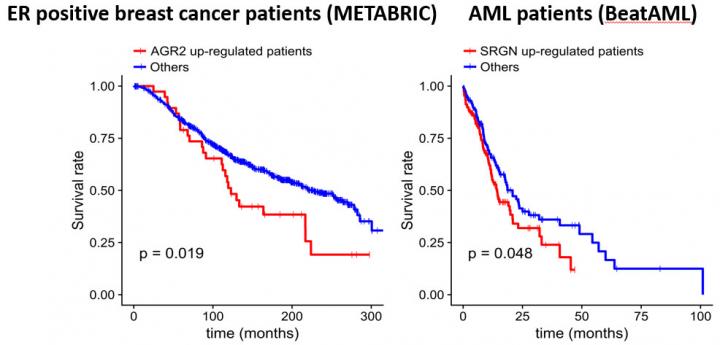A step closer to cancer precision medicine

Figure 1. Left panel: ER-positive breast cancer patients with AGR2 up-regulation showed less survival rate in the METABRIC study; Right panel: Acute myeloid leukaemia patients with SRGN up-regulation showed less survival rate in the BeatAML study. Credit: University of Helsinki
Why are the essential genes important in cancer?
Cancer is the leading cause of death worldwide. Cancer cells grow faster usually with the activation of certain genes. Targeted therapies aim at inhibiting these genes that are activated only in cancer cells, and thus minimizing side effects to normal cells.
High-throughput genetic screening has been established for evaluating the importance of individual genes for the survival of cancer cells.
Such an approach allows researchers to determine the so-called gene essentiality scores for nearly all genes across a large variety of cancer cell lines.
However, challenges with replicability of the estimated gene essentiality have hindered its use for drug target discovery.
“shRNA and CRISPR-Cas9 are the two common techniques used to perform high-throughput genetic screening. Despite improved quality control, the gene essentiality scores from these two techniques differ from each other on the same cancer cell lines,” explains Wenyu Wang, first author of the study.
How can we do better?
To harmonize genetic screening data, researchers proposed a novel computational method called Combined Essentiality Scoring (CES) that predicts cancer essential genes using the information from shRNA and CRISPR-Cas9 screens plus molecular features of cancer cells.
The team demonstrated that CES could detect essential genes with higher accuracy than the existing computational methods. Furthermore, the team showed that two predicted essential genes were indeed correlated with poor prognosis separately for breast cancer and leukaemia patients, suggesting their potential as drug targets (Figure 1).
“Improving gene essentiality scoring is just a beginning. Our next aim is to predict drug-target interactions by integrating drug sensitivity and gene essentiality profiles. Given the ever-increasing volumes of functional screening datasets, we hope to extend our knowledge of drug target profiles that will eventually benefit drug discovery in personalized medicine,” says Assistant Professor Jing Tang, corresponding author of the study.
Media Contact
All latest news from the category: Health and Medicine
This subject area encompasses research and studies in the field of human medicine.
Among the wide-ranging list of topics covered here are anesthesiology, anatomy, surgery, human genetics, hygiene and environmental medicine, internal medicine, neurology, pharmacology, physiology, urology and dental medicine.
Newest articles

First-of-its-kind study uses remote sensing to monitor plastic debris in rivers and lakes
Remote sensing creates a cost-effective solution to monitoring plastic pollution. A first-of-its-kind study from researchers at the University of Minnesota Twin Cities shows how remote sensing can help monitor and…

Laser-based artificial neuron mimics nerve cell functions at lightning speed
With a processing speed a billion times faster than nature, chip-based laser neuron could help advance AI tasks such as pattern recognition and sequence prediction. Researchers have developed a laser-based…

Optimising the processing of plastic waste
Just one look in the yellow bin reveals a colourful jumble of different types of plastic. However, the purer and more uniform plastic waste is, the easier it is to…



